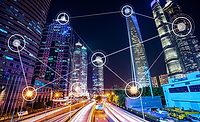The enhanced functionality made possible by the Internet of Things (IoT) and associated technologies is responsible for many of the major changes seen across society today. Video surveillance is one area that experiences substantial evolution driven by IoT and other smart technologies.
Enhanced Video Surveillance Functionality
The intelligent monitors and sensors of the IoT combined with emerging high-speed network solutions promise to improve the performance and capabilities of video surveillance systems. Presented below are two technologies that will drive the enhanced functionality of video surveillance equipment.
- Artificial intelligence (AI) and deep machine learning (ML) are bringing the power of analytics to unmanned video surveillance. Reliably trained AI systems enable extensive networks of surveillance equipment to be deployed without the need for human monitoring.
- Wireless communication technologies such as 5G and narrow band IoT (NB-IoT) improve the speed with which video feeds are made available to human and AI applications. The reduced latency improves the performance of video systems and elevates the user experience. NB-IoT’s signal penetration capabilities allow video cameras to be placed in previously inaccessible areas.
Applications of Advanced Video Surveillance
Advanced video surveillance capabilities have many applications in business, industry and society in general. Building intelligence into video surveillance systems enables them to better answer the questions for which they were initially deployed.
- What just happened? Intelligent video surveillance systems can easily search through large volumes of footage to identify interesting activity faster than legacy solutions.
- What is happening now? Automated analysis of current conditions can generate real-time insight enabling a rapid response to incidents.
- What will happen next? Using the raw material provided by video feeds, predictive analytics can alert organizations to potential issues so they can proactively mitigate risks before they become problematic.
Following are some specific ways enhanced video surveillance is being used productively.
Manufacturers benefit from enhanced video surveillance in multiple ways. Worker safety can be improved by restricting access to dangerous areas. Automated assembly line monitoring can ensure production objectives are met and address incidents promptly. Intelligent systems connected to IoT-powered video cameras enable predictive maintenance, resulting in more efficient plant operation.
Smart homes that can detect and restrict access to dangerous areas by toddlers or pets are possible with IoT-enhanced video surveillance systems.
Smart cities implement cutting-edge IoT video surveillance to monitor vehicle and foot traffic, addressing congestion problems. Predictive AI analysis may identify dangerous situations before they escalate and give decision-makers ample time to react. This information can also help avert disasters such as those recently experienced from catastrophic weather events.
Physical security is enhanced with IoT-enabled video surveillance systems in multiple ways. Smart drones can minimize the challenges involved with monitoring large areas like airports and campuses. Facial recognition software can be used to identify authorized personnel and restrict unauthorized individuals from entering a secure facility.
Retail establishments can use smarter video surveillance systems to better understand customer traffic patterns to tailor their offerings to consumer demand. Intelligent systems can identify problem behaviors such as shoplifting and alert the appropriate personnel.
Security Risks of IoT Video Surveillance
The connected nature of IoT implementations presents challenging security risks that need to be addressed to achieve the full potential of enhanced video surveillance. Every smart camera provides an attack vector through which hackers can potentially access to sensitive information and additional computing resources. Three main methods of abusing the power of IoT-attached video cameras are:
- Hiding cameras in hotel rooms or private residences that are used to steal credentials or create video clips of unsuspecting individuals to be sold on the internet.
- Compromising video security firms, enabling criminals to view numerous camera feeds in search of appropriate targets.
- Exploiting and exerting control over connected video cameras by using default configuration parameters that many customers fail to change.
These risks can be minimized by changing configuration parameters to limit access to video cameras, but they cannot be completely eliminated. As with many aspects of the connected world made available by IoT technology, society needs to accept the risks and the benefits.
A Safer Society
Video surveillance capabilities are enhanced by IoT technology. Smart cameras and connected applications can process visual information without human intervention, opening the door for the adoption of many automated processes. Securing these cameras is essential if they are to demonstrate their full potential. Used correctly, IoT-powered video surveillance will result in a more efficient and safer society.
This article originally ran in Security, a twice-monthly security-focused eNewsletter for security end users, brought to you by Security Magazine. Subscribe here.



